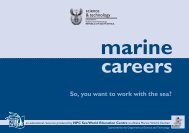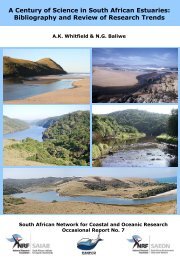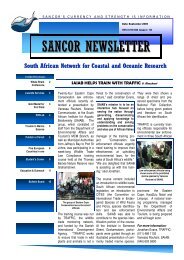SANCOR Newsletter -200 - Sancor home page - National Research ...
SANCOR Newsletter -200 - Sancor home page - National Research ...
SANCOR Newsletter -200 - Sancor home page - National Research ...
You also want an ePaper? Increase the reach of your titles
YUMPU automatically turns print PDFs into web optimized ePapers that Google loves.
Page 7<strong>SANCOR</strong> NEWSLETTER #<strong>200</strong>A global network for monitoring ocean acidificationBy Louis Celliers & Pedro MonteiroCSIR - Natural Resources and the EnvironmentIn the wake of a naonal workshop onOcean Acidificaon (OA) that was convenedin Cape Town in November 2012, Drs LouisCelliers & Pedro Monteiro were invited toaend an Internaonal Workshop to Developan Ocean Acidificaon Observing Networkof Ship Surveys, Moorings, Floats andGliders. This event was held at the Universityof Washington, Seale June 26 ‐ June 28,2012. This workshop was supported by theNOAA Ocean Acidificaon Program, the InternaonalOcean Carbon Coordinaon Project,the Global Ocean Observing System, theIntegrated Ocean Observing System, and theUniversity of Washington. The details of theworkshop, list of parcipants, agenda andthe eventual outcomes will be available onthe workshop website.This internaonal workshop was convened inorder to develop a proposal for an integratedglobal observing network for both carbonand ocean acidificaon that addresses therequirements of naons affected by thisemerging environmental problem in responseto societal needs.The internaonal workshop had five principalgoals. Firstly it were to provide the ra‐onale and design of the components andlocaons of an internaonal carbon oceanacidificaon observing network that includesrepeat hydrographic surveys, underwaymeasurements on volunteer observing ships,moorings, floats and gliders, taking into accountexisng networks and programs whereverpossible;. Furthermore the workshopaimed to idenfy a minimum suite of measurementparameters and performance metricsfor each major component of the observingsystem; develop a strategy for dataquality assurance and data distribuon; anddiscuss requirements for program integra‐on at the internaonal level.The 3‐day workshop was held at the Universityof Washington on June 26‐28, 2012 for agroup of 50‐60 internaonal sciensts andprogram managers.It was clear from the level of ongoing andexisng monitoring that there is a mismatchbetween the infrastructure and capabiliesof developing naons and developed naons(as seen in the figure below).The cost of providing plaorms for anyocean monitoring remains high. This is nodifferent for the deployment, operaon andservicing of sensors for the measurement ofOA parameters. These costs are a barrier forthe use of plaorm such as ships, gliders andmoorings.The resultant limited skills andcapacity available in developing naons isthe cause of large geographical gaps in theexisng global monitoring coverage.TheSeale workshop parcipants, primarilyfrom the northern hemisphere, acknowledgedthese gaps and expressed their interestand commitmentto contributeto the developmentof a trulyglobal OA network.(For sciencemedia coverageof theworkshophere).visitSouth Africa,through the workof the CSIRSouthern OceansCarbon‐ClimateObservatory Ocean acidificaon monitoring plaorms by type as of 2012(SOCCO), is an (source).excepon to thegeneral lack of skills and infrastructure on For more informaon on coastal and oceanthe connent, and represents a collecon of acidificaon contact Louis Celliersworld‐class assets for OA monitoring. The (lcelliers@csir.co.za) or Pedro Monteirosuccess of SOCCO has resulted in the devel‐(pmonteir@csir.co.za) of the CSIR.opment of a CSIR funded project entledThe Sensivies and Vulnerabilies of SouthernAfrican Regional Seas and their EcosystemServices to Ocean Acidificaon (SAVES‐OA). This four year project, in collaboraonwith other partners such as ACCESS, SAEONand DEA, will create the basis for the incep‐on of coastal OA monitoring in South Africa,and provide a plaorm for discussions onregional OA monitoring. The Western IndianOcean region, through the work of CSIR,WIOMSA, ASCLME and other instuons, isready to grow the capacity and skill to takepart in this global monitoring and scienceprogramme.South Africa is developing infrastructure,skills and capacity to play an acve role inthe fledgling global OA community. Thepotenal impact of OA on coastal communi‐es of Southern and Eastern Africa is trulyfrightening and the ability to measure andpredict these impacts is no longer a luxury.







